Are you ready to create your own online marketplace and disrupt your industry?
Marketplaces have emerged as a popular avenue for entrepreneurs to dive into the world of eCommerce and facilitate seamless connections between buyers and sellers. However, the process of building an online marketplace can be complex and overwhelming. But fret not, because we're here to guide you every step of the way. In this comprehensive guide to creating a successful marketplace, we'll take you through the entire process.
From defining your marketplace type and crafting a compelling value proposition to selecting a business model and developing your platform, we have all the insights you need. So grab a cup of coffee, get comfortable, and let's embark on your journey to marketplace success!
What is a marketplace?
An online marketplace is like a virtual shopping center where sellers offer their products or services. As a rule, online marketplaces are multi-vendor, which means there are multiple sellers within one website. They usually offer a wide variety of items, just like when you visit different stores in a mall.
There are several types of digital marketplaces, each serving different needs:
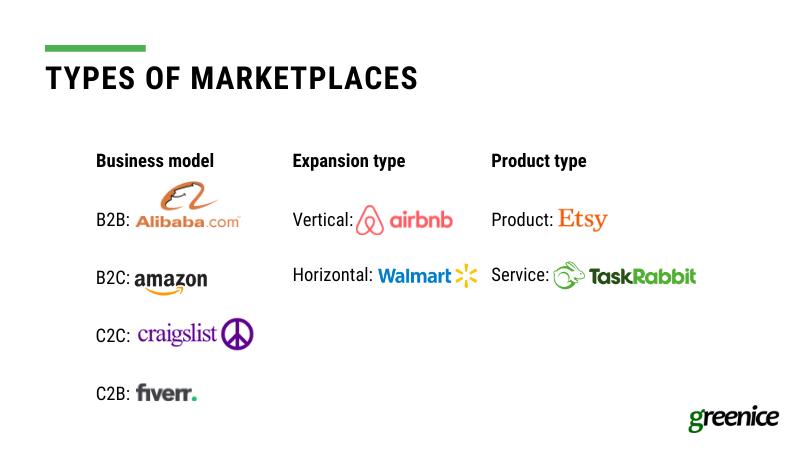
- B2B (Business-to-Business): This is where businesses sell products or services to other businesses. Imagine a company selling bulk office supplies to other companies, e.g. Alibaba.
- B2C (Business-to-Consumer): This is the most common type, where businesses sell directly to consumers. Think of your favorite online clothing store or electronics retailer, e.g. Amazon.
- C2C (Consumer-to-Consumer): Here, regular people sell items or services to each other, e.g. eBay or Craigslist.
- C2B (Consumer-to-Business): In this type, individuals offer their products or services to businesses. For example, a freelance graphic designer creating a logo for a company, e.g. Fiverr.
Additionally, marketplaces can be 'vertical' or 'horizontal':
- A vertical marketplace focuses on a specific type of product or service (like Etsy for handmade goods), e.g. Airbnb.
- A horizontal marketplace offers a wide range of different types of products or services, much like a large department store online, e.g. Walmart.
Marketplaces can also vary depending on what they offer:
- Product-Based Marketplaces: Focus on tangible goods ranging from electronics to handmade crafts, providing a platform for vendors to sell physical products to a wide audience, e.g. Amazon and Etsy.
- Service-Based Marketplaces: Cater to various services such as freelancing, home repairs, or educational courses, connecting service providers with customers in need of specific skills or assistance, e.g. Upwork and TaskRabbit.
Each type of marketplace caters to specific needs, making online shopping a versatile and convenient experience.
Why build a marketplace?
To see how profitable and massive this business is let’s look at some leaders in the industry. Amazon, with approximately 2.7 billion monthly visits, claimed the top spot as the most visited online marketplace, especially in the US, generating approximately $390 billion (in 2021). eBay followed in second place with around 789 million visits, and a GMV of $87 billion. Although Taobao, Tmall, and JD.com led globally, Amazon and eBay held their positions as prominent players.
By 2027, 59% of overall global retail sales will belong to online marketplaces. With an average commission of 11% is taken from each transaction, it is not difficult to imagine the magnitude of the profit from such platforms.
Creating an online marketplace is a lucrative business in today's digital landscape. Here are just a few reasons for its development:
For sellers:
- Increased Market Reach and Customer Access: Sellers can reach a wider audience than they could through their own individual websites or physical stores.
- Lower Barriers to Entry: New sellers can start selling with minimal setup, as the marketplace often provides the necessary infrastructure and customer base.
- Simplified Marketing: Marketplaces frequently offer a variety of product and shop promotion opportunities, significantly easing the marketing efforts for sellers.
- Collaboration and Value Creation: Sellers can collaborate with the marketplace and other sellers to create bundles or joint promotions, adding value to their offerings.
For buyers:
- Builds Customer Trust and Offers Convenience: Marketplaces usually have systems in place to ensure buyer protection and offer a convenient one-stop-shop experience.
- Encourages Competition and Innovation: Buyers benefit from the competition among sellers, which can lead to better quality products and services at competitive prices.
- Diverse Choices: Buyers have access to a wide range of products and services from different sellers, all in one place.
- Value Creation: Buyers can benefit from collaborations between sellers, such as bundled offers or innovative product combinations.
- Ease of Comparison: The ability to easily compare products, prices, and seller ratings within a marketplace enhances the buying experience.
For marketplace owner:
- Diverse Revenue Streams and Cost Efficiency: Owners can monetize through various channels like commissions, listing fees, or advertising, and they benefit from economies of scale.
- Scalability and Adaptability: As the market evolves, owners can scale up or adapt their platform to meet changing demands and trends.
- Establishing a Community: By facilitating a platform for buyers and sellers, owners can create a community, enhancing customer loyalty and engagement.
- Lower Risks: Owners bypass the high costs of buying and reselling products, instead earning revenue from transaction fees facilitated by buyers and sellers.
Not bad, right? Now, let’s figure out how to build your own marketplace.
Steps to build marketplace
You will have the following steps:
- Step 1. Define the Market Niche
- Step 2. Conduct Market Research
- Step 3. Determine Your Marketplace Value Proposition
- Step 4. Choose a Business Model
- Step 5. Choose and prioritize features
- Step 6. Decide on Technology and Development Path
- Step 7. Build an MVP
- Step 8. Launch and grow
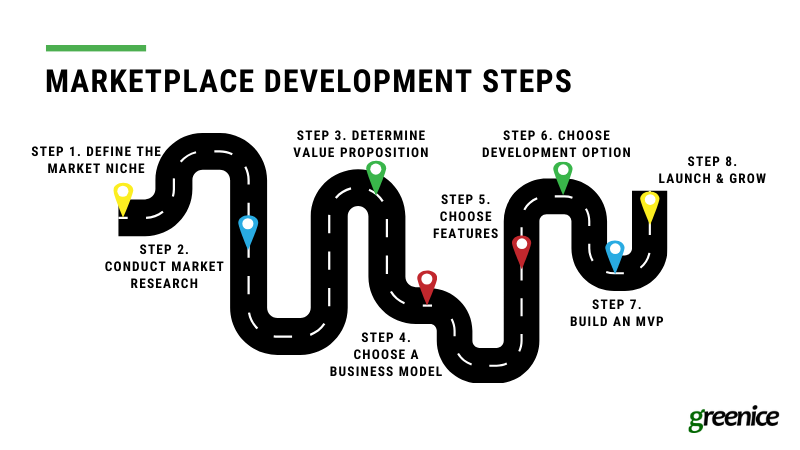
Step 1. Define the market niche
To understand what niche you must choose ask yourself three questions:
Where do you have a lot of experience and knowledge?
It is crucial to leverage all your expertise in building a successful marketplace. Identify areas where you have expertise and a strong understanding, as this will give you a competitive advantage in the market. By capitalizing on your existing strengths, you can differentiate yourself from competitors and position your marketplace as a trusted and reliable source within your chosen industry.
Which market niches are growing?
By actively monitoring industry trends and market dynamics, you can identify niches that are experiencing significant growth. This allows you to align your marketplace with these trends and capitalize on emerging opportunities. Being aware of the latest developments and customer demands empowers you to adapt your marketplace strategy and offerings accordingly, ensuring that you are riding the wave of growth and staying ahead of the competition.
What is your perfect niche?
The perfect market niche has:
- Minimum level of competition. Ideally, if there will be no competitors at all, but this is now possible only in developing countries or when a new category of goods appears on the market, such as smartphones and smart watches at the end of the zero years of this century. Now the new categories of goods can be called virtual reality helmets.
- Adequate market demand. Not always people in the region where your marketplace will work will buy certain goods. For example, you can see why it’s a bad idea to sell snowmobiles in Hawaii or gadgets that use cloud technology in regions with poor internet connectivity.
Here are niche examples to help you navigate:
| Niche | Description |
Examples | Our guides to read |
| CONSUMER PRODUCTS | eCommerce marketplaces like Amazon, AliExpress, and Wish are huge in the world of online shopping. They offer a vast range of products from multiple sellers, providing a seamless and secure shopping experience. With a global reach, convenient payment options, and customer reviews, consumer products marketplaces have transformed the way we buy and sell products online. | Amazon, AliExpress, and Wish | |
| REAL ESTATE | Real estate is a multi-billion dollar market. Like most everything else these days, people are searching for property online. A huge majority of Americans, 90%, use agents when they want to buy or sell a home. But to find an agent, people use the Internet. Real-estate platforms can help them speed up their search using exact parameters. The platforms can subdivide into smaller niches like residential, commercial, or industrial listings. Pay attention to the areas that are still untapped. | Zillow, Trulia, Airbnb | |
| HOME SERVICES | In the past, if people needed a plumber, builder, or nanny, they could ask for a recommendation from a neighbor or look up the ads in the newspaper. Today, it is much simpler with online marketplaces for on-demand services. Home services niche is growing tremendously. The popularity of such platforms is growing every year as more and more people feel comfortable hiring a specialist after studying his or her profile and online reviews. | Houzz, Taskrabbit, Thumbtack, HomeAdvisor, Angi | |
| HEALTHCARE | Finding a doctor or a caregiver is easier with online platforms for on-demand care services where you can choose from hundreds of nurses in your neighborhood. Even previously illegal medicine like cannabis now can be found on specialized portals that help find the nearest pharmacy. | Babylon, Mavencare, Doctolib | |
| FINANCE | Borrowing money from friends is often impossible. Especially if you need a large amount. Banks demand high credit scores and charge high interest. Peer-to-peer lending and crowdfunding platforms can help. Every year around $18 billion is crowd-funded in North America alone! If you wonder how a startup can compete with Kickstarter in crowdfunding and with Lending Club for loans, then you should dig deeper to find narrower niches in these areas. | GoFundMe, Indiegogo, Prosper | |
| EDUCATION | Life-long education is a must in today’s business environment. Foreign languages, Harvard courses, MBA, mindfulness, yoga, nutrition, you name it. Anything under the sun can be studied online. And while self-paced courses are just a part of the education system, millions of students worldwide are looking for an online tutor. | Coursera, Udemy, Domestika | |
| JOBS RECRUITMENT | Today, hardly anyone looks for a job in the newspaper. The chances are much higher to find a job via the Internet. Job marketplaces like Glassdoor and Indeed are incredible when one wants to find career options. Upwork and Fiverr are the leaders of the freelance market. But the demands of the audience rapidly change and you may be able to find an unexploited opportunity! | Glassdoor, UpWork, Fiverr | |
| TRAVEL | An online marketplace in the travel industry is a gateway to endless possibilities. It connects travelers with local guides, tour operators, and accommodation providers, offering a wide array of unique experiences. From stunning landscapes to cultural encounters, this marketplace brings dreams of wanderers to life, making travel arrangements convenient and unforgettable. | Tripadvisor, TripIt, CityMapper, Agoda |
Step 2. Conduct market research
When creating an online business, understanding your target audience and conducting thorough market research are crucial. So what do you need to know?
Learn Your Target Audience:
It's essential to know who your potential customers are - their needs, preferences, and behaviors. This means diving deep into demographics (age, gender, location), psychographics (interests, values, lifestyle), and understanding their online shopping habits. By comprehensively understanding your audience, you can tailor your marketplace to meet their specific needs, leading to higher engagement and sales.
Research Your Competitors:
Equally important is understanding your competition. What are other marketplaces in your niche doing? Analyze their strengths, weaknesses, and the strategies they use to attract and retain customers. Look into the variety of products or services they offer, their pricing strategies, customer service approaches, and technological features. By identifying what works well for your competitors, you can learn best practices and also find opportunities where your marketplace can differentiate itself and excel.
A deep understanding of your target audience and a thorough analysis of your competitors form the bedrock of a successful online marketplace. These insights guide your strategic decisions, from website design and feature implementation to marketing strategies and customer service approaches.
Step 3. Determine your marketplace value proposition
The most common reason for a startup to fail is that it does not solve a market problem. With the great variety of existing platforms, how can you build a marketplace website that will be competitive in the market? What unique value can you offer customers that others can not?
The first thing that makes a marketplace great is the ability to not only consolidate the market offerings in one place but also to enhance the service, bringing the customer experience to a never-seen-before level.
Bill Gurley, a general partner at venture capital firm Benchmark which funded many startups like Instagram, Snapchat, Uber, Twitter, and more, names ten factors of marketplace success:
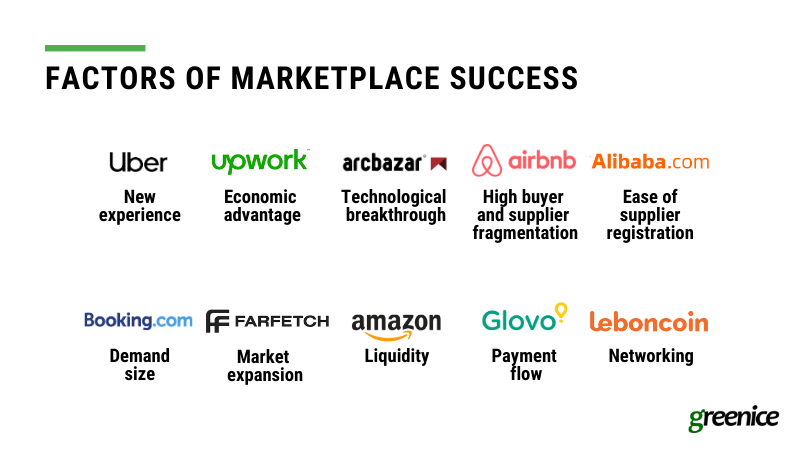
- New experience. The Uber application made it comfortable for travelers to search for a taxi in an unknown place by simply booking it through the app.
- Economic advantage. The marketplace should help people save their resources, time, and money. Upwork allows companies and individuals to quickly find quality specialists in any part of the globe while still saving money.
- Technological breakthrough. Technologies simplify many routine processes. Uber created the ability for users to book a taxi from a mobile phone, track the driver’s location, send the location to friends, rate the driver, and share payments. For one of our clients, Arcbazar, an architectural contests marketplace, we created an AI-based price recommendation system that suggests an optimal award sum for project winners. This feature saves clients time and eliminates stress when they have to make a decision.
- High buyer and supplier fragmentation. Catering to different audience segments, you attract more people to your platform. For example, Airbnb provides accommodation options for different types of travelers — from economy to luxury. That increases the marketplace value and revenue.
- Ease of supplier registration. A difficult sign-up process may de-motivate the businesses from registration. For example, to start selling goods at Alibaba, vendors need to endure a legitimacy and verification procedure. On the contrary, at Etsy, you can just create a profile and start selling right away. However, verification is important for trust-building so in many cases it cannot be omitted. Just think of facilitating the process with the help of special services.
- Demand size. Make research on if the market is ready and big enough to have an online alternative. Some industries, like Healthcare, are huge but the offline players are very strong and hinder the new online platforms so it may take a lot of persistence to break through the hurdles.
- Market expansion. Uber’s concept expanded to other countries outside the US, allowing travelers to use their service all over the globe while increasing the revenue of the platform. They created workplaces for millions of people around the world and made the trips cheaper than it was by traditional taxi.
- Liquidity. Uber, Airbnb, and Amazon satisfy the popular needs of the masses, and that increases their popularity. Vertical marketplaces with rare goods and services run the risk of low traffic.
- Payment Flow. The marketplace should charge the commission when the customer pays the seller. Such ‘invisible’ cutting of the fee during the transaction is better than billing the supplier a large sum at the end of the period. Psychologically, such a charge is not perceived by the sellers as an expense and, thus, brings less frustration.
- Networking. Uber attracted many drivers, creating a diversity of choice and the ability to provide instant service. With a system of ratings, passengers can view the credibility, reliability, and safety of the driver.
Step 4. Choose a business model
To monetize your online marketplace, you have various business models to choose from:
- Commission: Charge a fee on each transaction. Use an escrow system for trust, where funds are held until the buyer confirms receipt, then release the money minus your commission. This is common in both general and niche marketplaces, with the latter often charging higher fees due to less competition. Example: Shutterstock.
- Membership/Subscription Fee: Charge users a recurring fee to access your platform. This is effective for services where value is hard to quantify. To attract sellers, consider offering a free trial. Consistent revenue is generated, even if platform usage varies. Example: Home Exchange.
- Listing Fee: Sellers pay for each listing. This model works best when combined with others, as solely relying on listing fees can be challenging in attracting repeat listings. Example: Etsy.
- Freemium: Offer basic services for free, with paid options for advanced features. This approach requires balancing free and premium services to encourage upgrades. Example: Etsy.
- Featured Listings and Ads: Allow free listings but charge for enhanced visibility or advertisements. This is effective on platforms with many similar listings, but be mindful of user perceptions of sponsored ads. Example: OpenTable.
- Lead Generation Fee: Charge sellers for each lead provided, regardless of conversion. This is suitable for high-value leads but may face challenges with lead quality and conversion. Example: Thumbtack. Each model has its advantages and challenges, and often, a combination of these methods yields the best results.
Step 5. Choose and prioritize features
When choosing features for your online marketplace, it's essential to balance must-have functionalities with extra, innovative features.
Buyer Panel should include:
- Product Search Functionality: Easy-to-use search with keywords, categories, and filters.
- Saved Searches: For quick access to previously searched items.
- User Accounts: Including shipping address, financial details, wish lists, order history, and preferences.
- Shopping Cart/Checkout: Seamless purchase process with multiple payment and shipping options.
- Order Management: Track purchase history and current order status.
- Messaging Capabilities: Direct communication with sellers.
- Returns and Refunds: Clear process for handling these needs.
For marketplaces with competition there must be additional features like:
- Solution or bid list page: Each challenge has a dedicated page that showcases solutions or bids.
- Transparent winner selection: The mechanism for selecting and notifying the winner(s) is transparent, either through user voting or the seeker's decision.
Seller Panel should include:
- Profile Creation and Verification: Including document verification for authenticity.
- Virtual Store Creation: Personalized store fronts within the marketplace.
- Product Uploads and Management: Easy listing and order management functionalities.
- Shipping Integration: For streamlined delivery processes.
- Payment Options and Management: Diverse and convenient payment methods.
Here are some safety features to improve user experience within your platform:
- Trusted Payment Methods: Provide well-known, secure payment options for enhanced customer trust.
- User Verification: Use strong verification to authenticate accounts and prevent fraud.
- Review Authenticity Algorithms: Implement algorithms to ensure genuine user feedback.
- Secure Transactions: Ensure transaction safety with escrow services and secure gateways.
- Fraud Prevention: Utilize AI and ongoing surveillance to detect and prevent fraudulent activities.
Admin Panel should include:
- User and Fee Management: Manages user accounts and sets fees, essential for operational balance.
- CMS (Content Management System): Updates and manages site content, keeping it current and engaging.
- Reports: Provides valuable insights for informed decision-making.
- Rating and Reviews Oversight: Maintains credibility by monitoring customer feedback.
- Emails and Notifications: Enables direct communication with users.
- Advertisement Management: Manages ad placements for revenue and relevance.
- Support Desk: Central hub for addressing user inquiries, ensuring satisfaction.
Considering recent trends, you can also include features like:
- Video Shopping: Utilize video content to engage globally and set new eCommerce trends through video shopping.
- New Payment Options: Adapt to evolving technologies and preferences by offering diverse, modern payment options.
- Social Commerce: Leverage the integration of social media and eCommerce for a new, social shopping experience.
- Personalization: Offer personalized shopping experiences, such as custom recommendations and emails, to meet customer expectations.
- AR, VR & the Metaverse: Embrace AR, VR, and Metaverse technologies to create innovative and immersive eCommerce experiences.
These trends address evolving customer expectations and technological advancements, positioning your marketplace at the forefront of e-commerce innovation.
Artificial Intelligence
Today, Artificial Intelligence is increasingly integrating into every aspect of our lives, with eCommerce being one of the foremost sectors to embrace and be transformed by AI technology. AI functionality can be utilized across different aspects of your marketplace:
For Buyers:
- Enhanced Search: AI improves search accuracy and speed, enhancing the overall shopping experience.
- Personalized Product Recommendations: AI analyzes user preferences and browsing history to suggest products, increasing engagement and potential sales.
- AI-driven Chatbots: These offer responsive customer service, handling inquiries and resolving issues effectively and round-the-clock.
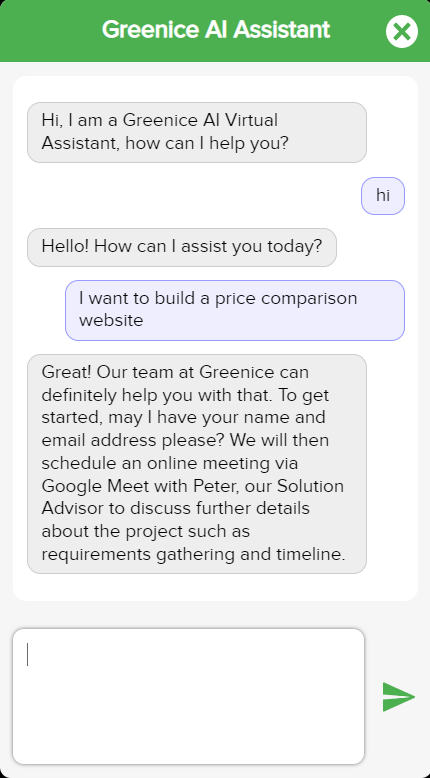
For Sellers:
- Marketing Automation: AI can personalize marketing efforts, targeting users with ads and offers that align with their shopping habits.
- Dynamic Pricing: AI algorithms provide real-time pricing suggestions based on market trends, aiding in competitive pricing and profit maximization. AI can also help with price comparison features.
- Inventory Management: Predictive AI helps manage stock levels efficiently, reducing overstocking or stock shortages.
For Admins:
- Predictive Analytics: AI analyzes data for insights on customer behavior and sales trends, aiding in informed decision-making.
- Fraud Detection: AI helps identify and prevent fraudulent activities by monitoring transaction patterns.
Incorporating AI into your marketplace elevates operations, enhances user satisfaction, and drives business success. Our expertise in developing these AI features positions us to create a marketplace that's not only functional but also ahead of the curve.
Dreaming of Making Your Mark in the Digital World?
Contact UsStep 6. Decide on technology and development path
When deciding on the technology and development approach for your online marketplace, you have several options to consider, each with its own set of advantages and challenges.
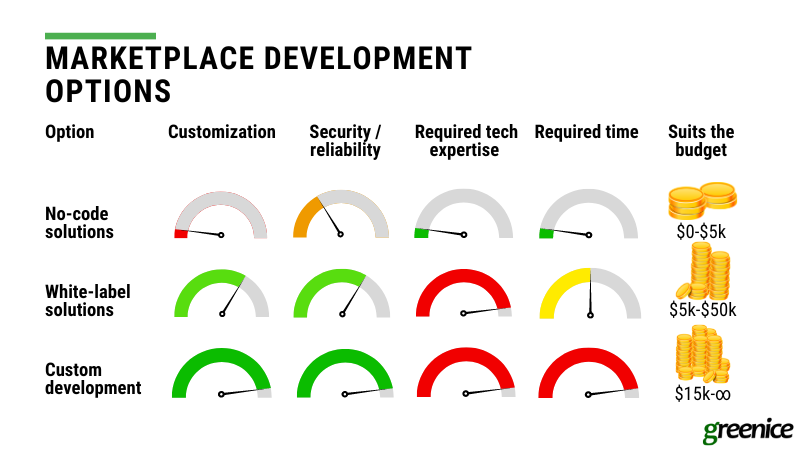
- Off-the-Shelf (No Code) Solutions are becoming increasingly popular. These platforms allow you to create a marketplace without any coding knowledge. They offer a balance between customization and ease of use, with limitations in terms of unique feature development. One of the examples is Sharetribe.
These platforms provide pre-designed templates, tools, and functionalities that can be customized to suit specific business needs. To create an online marketplace using these solutions, entrepreneurs typically need to choose a suitable platform, select a marketplace theme, set up product categories, configure payment gateways, and integrate essential features like product listings, user profiles, and search functionality. - White Label Solutions - pre-made platforms that you can customize with your brand and specific features. These solutions provide a cost-effective and speedy way to develop a marketplace, ideal for those with budget constraints. They allow rapid deployment and significant customization, offering essential features like product and order management.
However, they require some technical know-how for setup and customization, which could be a hurdle for non-tech-savvy users. Additionally, the shared codebase means reduced exclusivity and potential security concerns. Support might be limited, which can impact maintenance and troubleshooting. In essence, while White Label Solutions offer affordability and quick market entry, they come with considerations of technical expertise, support limitations, and security risks.
These solutions, found on platforms like GitHub or available for purchase on sites like Envato, range from open-source to paid licenses. - Building from Scratch refers to the creation of a marketplace entirely from the ground up, tailored specifically to a client's vision, offering full customization and control over the platform. This option is best suited for those with unique marketplace needs or who require specific functionalities not available in pre-made solutions. It requires more time and investment but can result in a highly tailored product. For example, NoCowboys and ArcBazar. You can read more about these custom-built marketplaces in our case studies.
Each of these options should be evaluated based on your specific business needs, technical capabilities, budget, and the time you can dedicate to the development of your online marketplace.
Step 7. Build an MVP
Before jumping into long-term, costly development, you can create a minimum viable product and test it in the market. You will be able to get feedback from users before building the final version of the software or application.
An MVP allows a startup to launch faster with minimal investment. It is enough to build core functionality that represents the main idea to the customers. This approach allows the startup to be flexible and to change the product early without the serious time and money loss.
What is even more important is that you can create an MVP without coding on your own. Use one of these methods to create an MVP.
Step 8. Launch and grow
Launching an online marketplace is an exciting venture but success doesn't come overnight. Once the marketplace is up and running, it's crucial to actively seek feedback from real users and continuously strive to improve the platform.
By collecting feedback from both buyers and sellers, we can identify areas of improvement and implement necessary changes to enhance the user experience. This iterative process ensures that the marketplace evolves in line with the needs and preferences of its users, leading to greater satisfaction and increased engagement.
So, whether it's streamlining the checkout process, optimizing search functionality, or enhancing mobile responsiveness, constant feedback and improvement are the keys to building a successful online marketplace.
How much does it cost to build a marketplace platform?
Each marketplace has its own peculiarities that influence development time and budget. Roughly speaking, you have two options - use off-the-shelf solutions, white label solutions or build it all from scratch.
OFF-THE-SHELF SOLUTIONS
Using such canned solutions you can fit into a $5,000 budget to create a marketplace equipped with basic functionalities. The overall cost depends on the prices of themes, plugins, and integrations you use.
White label solutions
The prices for white-label solutions are pre-defined so you can calculate approximate expenses. Depending on the type of your marketplace and features complexity you will spend from $5,000 to $15,000. But, again, it can go way beyond or under it - all depends on your needs.
Custom marketplace development
Our team develops fully customized projects so there is no fixed price for all solutions.
The total cost of the project depends on many factors:
- The readiness of the software requirements specifications (SRS)
- Stage of the project (some projects were started before us and need remodeling or enhancing)
- The complexity of the functionality
- Uniqueness of features
- Integrations with other services
- The urgency of the project
Many features are more or less similar from project to project. Registration, user profile creation, search, payment integration, and reports are the core features of any marketplace. A marketplace with basic features can be estimated in around 600 – 900 hours and the costs start from $15,000.
Then, depending on the marketplace type and specifics, the features will differ. For example, to build a website like Etsy, you will also need such features as Seller verification, Listing pages, Shopping cart, Order management, Shipping integration, Refunds, and Reviews. You will probably need an additional 450 – 700 hours and $16,000 – $24,500 to launch the final version.
Marketplace development process at Greenice
If you hire us, here is how we’ll work:
- Discovery
- UX/UI Design
- Development
- QA
- Deployment
- Maintenance
Now let’s move on to the technical part and plan how to build an online marketplace.

1. DISCOVERY PHASE
During the discovery phase, you will identify business goals, and user roles, and collect all the requirements of the future software. Our Business Analyst, together with our Project Manager and Team Lead will analyze your project from different angles and create system requirements specifications (SRS). This document should describe the system functionality, its features, wireframes, measurable deliverables, timeline, and budget estimate. This will cut the development time, allow the team to get an overview of the scope of the tasks, and optimize the priorities. This phase may take from two weeks to a couple of months depending on the complexity of your project.
2. UX/UI DESIGN
Just as building a house is impossible without architectural drawings, software development must also start with web design. Programmers need to have a visual representation of the User Interface. There are many ways to get a design. You can buy a ready template; or you can order a custom design from a freelancer, from a web studio, or from our in-house designer. When the design is ready, we can start coding.
3. DEVELOPMENT
In the development phase, our developers breathe life into the online marketplace. They craft the foundation of the marketplace, weaving lines of code to create features like user registration, product listings, search functionality, shopping carts, and secure payment gateways. It's an essential process where the marketplace takes shape and becomes a dynamic entity.
4. QA
The quality assurance (QA) phase safeguards the marketplace from potential pitfalls before its grand debut. Through a series of comprehensive tests, it fortifies the platform, making it resilient, dependable, and user-friendly. By ironing out any bugs and glitches, the QA phase ensures users can immerse themselves in a glitch-free marketplace adventure. Testers polish the product, ensuring the marketplace is perfect for its users.
5. DEPLOYMENT
In the deployment phase, a functional product that fulfills its main purpose is ready to see the world.
We, as a web development company, ensure a seamless and successful launch of your online marketplace. Our team configures servers, databases, and conducts thorough testing to guarantee optimal performance and security. With our expertise, your marketplace will be ready to serve users efficiently. Trust us to handle the technical aspects and deliver a smooth deployment process for your innovative platform.
6. MAINTENANCE
Our goal is to create self-maintainable software projects that require minimal maintenance. We achieve this by leveraging Amazon Web Services (AWS) and Kubernetes. AWS ensures high uptime and handles all maintenance and updates, allowing you to focus on other tasks. Kubernetes provides scalability, fault-tolerance, and consistency throughout the development process. Additionally, we offer on-demand bug-fixing and upgrades, as well as a six-month code warranty to address any issues that may arise. Note that third-party integration-related bugs are not included in the warranty.
Ready to Launch Your Marketplace Dream?
Contact UsOur experience in building marketplaces
Being in custom web development since 2007, we have completed more than 200 successful projects. The first priority for us is the security of data and transactions; therefore, we use only the most innovative and reliable technologies and partnerships.
We are proud to be a development partner for such large players as Arcbazar and NoCowboys, marketplaces that successfully and profitably provide services in their respective niches. Here are just a few of our successful projects:
NoCowboys
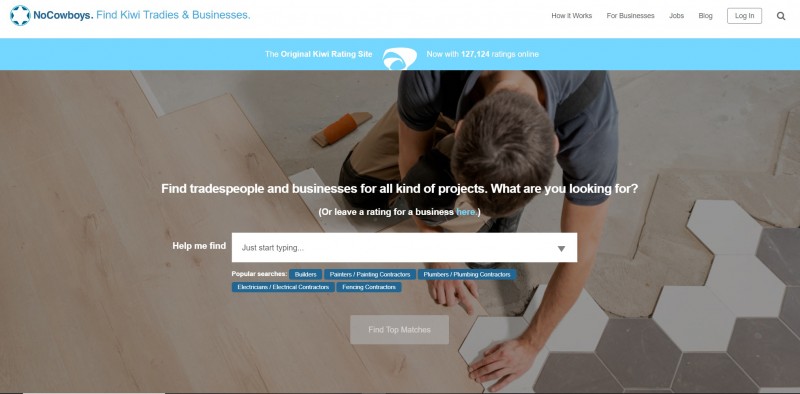
NoCowboys, a leading review website in New Zealand since 2004, partnered with Greenice in 2016 to enhance their system. We refactored their complex codebase, upgraded the CRM, and improved website UX. These optimizations led to faster development, increased security, and better performance.
The new CRM simplified daily operations, while a revamped search engine and rating validation measures made the platform more attractive and user-friendly. Automation of data processing and subscription renewal saved time and reduced errors. Together, we transformed NoCowboys into a streamlined and efficient platform for finding reliable home service providers.
MotionElements

MotionElements is a leading Asian marketplace for stock media. We revamped MotionElements' website by rewriting its backend using Laravel, enhancing overall performance and scalability. Additionally, we integrated Elasticsearch to improve the site's search functionality. These upgrades resulted in a more efficient, user-friendly platform, boosting user engagement and sales. The enhanced search experience particularly improved navigation and accessibility for users, solidifying MotionElements' market position.
BizSalebyOwner
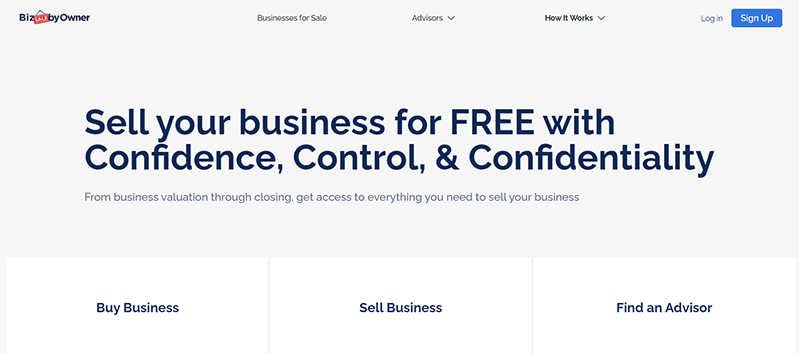
BizSaleByOwner is an innovative marketplace that facilitates the sale of businesses, offering expert consultations throughout the process. When our client approached us with their initial concept, resembling platforms like Upwork, we advised them to start with an MVP. The initial platform allowed users to post ads for selling their small businesses. We then expanded the platform by introducing a valuable feature that enables users to connect with specialized counselors who can provide guidance and support for both buying and selling businesses.
Arcbazar

Arcbazar, an interior design contests marketplace, partnered with Greenice to enhance their online designer marketplace. We addressed challenges such as tangled code, lack of international scalability, and user difficulties in setting project awards. Our team refactored the code, improved platform efficiency, and added support for multiple languages and currencies. We also implemented an ML-powered award suggestion system, boosting user engagement and satisfaction. We also implemented a feature where contestants can tag decor and furniture shops directly on their design projects, simplifying the customer's search for project items.
Conclusion
In this guide, we answered the most essential questions on how to build a marketplace website. We’ve discussed types of marketplaces and their peculiarities, must-have features, steps of creating a marketplace and approximate prices. We will be glad to start working on your project. All that we need is to get acquainted with your idea and understand the business logic and features you want to have. We can also offer our help in creating specifications for your startup. Let’s start working together today!
FAQ
What is an online marketplace?
An online marketplace is a digital platform where multiple vendors can sell their products or services to customers. It's like a virtual mall with various shops under one roof.
What are the different types of online marketplaces?
Online marketplaces can be categorized as B2B (Business-to-Business), B2C (Business-to-Consumer), C2C (Consumer-to-Consumer), and C2B (Consumer-to-Business).
How do online marketplaces make money?
Marketplaces can generate revenue through commissions, subscription fees, listing fees, lead generation fees, a freemium model, and featured listings and ads.
How much does it cost to build a marketplace website?
The cost varies based on your approach:
- Using white-label solutions or platforms like Shopify or WordPress, costs typically range from $5,000 to $15,000. This can vary based on the complexity and specific features you need.
- Custom Development of a basic marketplace starts at around $15,000 (at Greenice) and can increase depending on complexity, with more advanced features and integrations.
Overall, the cost depends on your specific requirements and the development path you choose.
How do I create an online marketplace?
To create an online marketplace, start by defining your niche and understanding your target audience. Choose the right technology platform - consider white-label solutions, custom development, or no-code platforms based on your needs and resources. Focus on essential features for buyers, sellers, and admins, and consider incorporating AI for enhanced functionality. Develop a clear monetization strategy, such as commissions, subscription fees, or ads. Launch with a minimum viable product (MVP) to gather user feedback, and then iterate and improve based on that feedback. Implement effective marketing strategies to attract users and continuously analyze your platform's performance for ongoing optimization and growth.
Remember, creating a successful marketplace requires a balance of good technology, user-friendly design, strategic marketing, and continuous adaptation to user needs and market trends.
NEED HELP IN BUILDING A MARKETPLACE STARTUP?
Contact UsRate this article!
5




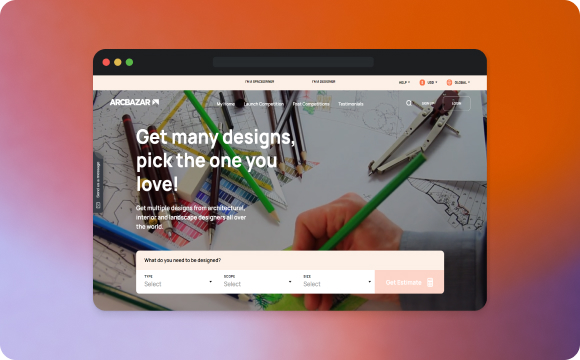
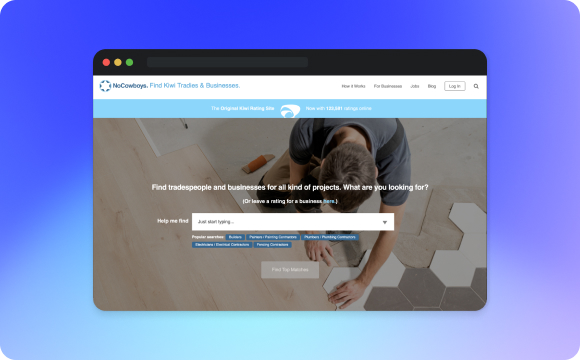



 Sign in with Google
Sign in with Google
Comments (0)